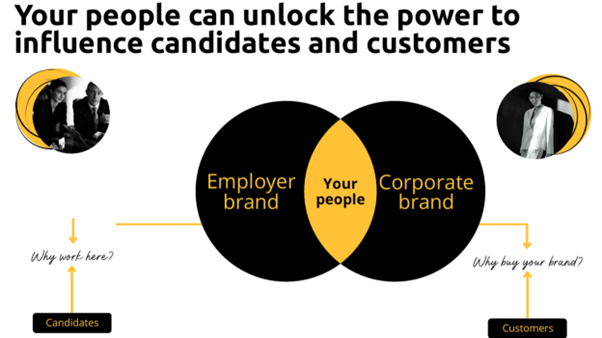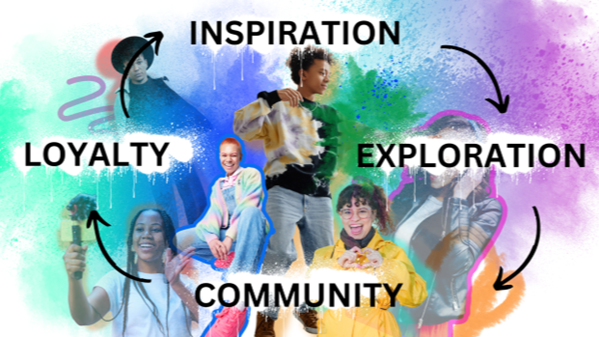Your Employer Brand is having an identity crisis

They’re funny old things, Employer Brands. Often making the podium for ‘CEO priorities’, they’re hailed as the ‘solution’ in a competitive talent market, then left chronically under-resourced. Listen to any podcast about ‘measuring the impact of your EB strategy’ and you’ll be underwhelmed by the vagaries. From hero to rejection, speaking in a language no one understands…I mean, if your EB was a person, they’d be pretty messed up!
The specialisation is still ‘only’ about 20 years old, which in the scheme of things, is pretty young. But I don’t think we’re doing ourselves any favours – I believe we need to get clearer on the definitions, roles, value and impact of our Employer Brands if we’re to really shift the dial.
Some areas where the notion of ‘Identity’ keeps popping up for me.
1. Your organisation needs a common language
The CEO says she wants a magnetic ‘Employer Brand’, so you go to an external agency to ‘create one’ and they make you a snazzy website. The CEO was likely meaning ‘reputation as an employer’, which comes from having a great culture, developing people’s skills, being a nice place to work (etc), not JUST the way you communicate about your company as a place to work. Where does it start, where does it end?
I don’t want to open the obvious can of worms about EVP / EB / Talent Brand / Recruitment Marketing and all the buzzword bingo we can play. What I will say is:
- Create language that works for your organisation – maybe you call it a people promise, maybe you don’t. It doesn’t matter. What matters is that you all agree on the terms and you consistently use them. Become the ‘Definition Police’ (Joking…sort of). Only when you speak the same language can you really get into how it will be measured, the goals, resourcing required and value created.
2. Be careful what you wish for. Do you ‘own’ or ‘enable’?
It’s not uncommon to hear people say that the Employer Brand ‘drives retention’. What, more than having great managers, or a high trust working environment? In a recent request to tender we received, the brief stated that the EVP would be measured on areas such as Diversity, Engagement and Retention.
I think we’re in danger of over-hyping, over-owning or over-inflating the role of the Employer Brand here. It’s no silver bullet for a broken culture, or inability to match market-rate salaries.
- With so many variables on outcomes, don’t over-reach the impact of the Employer Brand. Once you are clear on your definitions (see number 1), selectively align your outcomes to the business goals and talent strategies and consider focusing less on ‘owning’ and more on ‘enabling’. In a sense, you might think it devalues the role of the Employer Brand, but there are times when being realistic and practical will create more credibility and trust… which ultimately puts you in a place to create more value. Less, may really be more.
3. One Brand. Zero identity.
(I am stretching the true definition brand identity here - apologies in advance to the purists out there).
10-15 years ago the Employer Brand used to have its own identity, aligned to the Masterbrand (sometimes very loosely), but still quite distinctive in its look, feel and tone.
Today, at the other end of the spectrum, we risk ‘one brand’ thinking creating vanilla communications with no cut through since all of the EB’s personality and ‘identity’ has been stripped out. The only thing that differentiates one social post about benefits or career profile from one organisation to another is often just the logo. With only a few exceptions, an EB should be closely aligned to the corporate brand – but here are some things to consider if you find your talent comms have gotten too “same-y”
- Take a hard look at your relationship with your brand/marketing teams. We often see a lack of understanding between teams - sometimes strategic but often tactical, about the sheer variety of talent comms you may need, and how a single ‘brand line’ won’t cut it. Like the points above, EB teams need to be very clear on the definitions, the areas they enable, and the tools they need to effectively impact multiple talent touchpoints (which are perhaps many more than consumer marketers are used to). Build the case for alignment, balanced with the need for impact.
- Don’t forget the ‘brand’ bit of Employer Brand. Some challenges of ‘one brand’ can be overcome with more rigorous (data-informed) strategy. If your EVP over-indexes on organisational factors like purpose, strategy and the company’s products – you’re not building all areas of the EVP that are of interest to talent. Ensure your pillars contain more about the actual career experience to help differentiate you.
- Don’t forget your EB’s personality and tone. By relying on the corporate brand’s tone of voice, you may be missing the real essence of the EB’s identity. There is always a vibe and vernacular within a business, and often it’s not the same as how you’d speak to investors or consumers. Spending time on your EB’s identity will not be wasted!
4. Talent’s sense of identity has radically altered, so your EB strategy must too.
The great resignation fast became the great re-evaluation for millions of workers. What do I want out of work? How far am I prepared to commute, if at all? What am I prepared to sacrifice for this role?
Without getting too deep, I believe people are re-evaluating themselves, and ultimately becoming slightly less defined by ‘work’. Their own sense of identity is shifting.
The early adopters are already here, or moving fast to create more human businesses – supporting work from anywhere, designing family friendly policies, advocating for social impact and building deeply connected teams. Some organisations are moving more slowly but I have not met anyone in the last year that is not somewhere on this journey.
- The notion of an ‘EVP deal’ has been around forever, framing the 2-way street of what talent needed to bring (skills etc) and what the company gave back in return (pay etc). At TQ we’ve moved our methodologies to really capture the more emotional dimensions of the deal - so in your strategies and tactics, be sure to meet talent where they are at emotionally too (not just the channels they hang out in) – how might they ‘feel’ about the career experience at your organisation? What can you offer talent by way of helping them realise their shifting sense of identity? Maybe it’s becoming a new parent, losing a parent, going through menopause or exploring their own connection to purpose - whatever it is, allowing your EB identity to align to an individual’s will be incredibly powerful going forward.
There are some slightly half-baked ideas in here, I know, but there is significant change happening in this space and I think we need to look at it from new angles to really make it sustainable, valuable and impactful.
How has your EB identity, however you interpret that, shifted recently?



